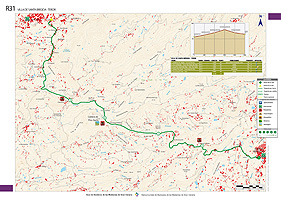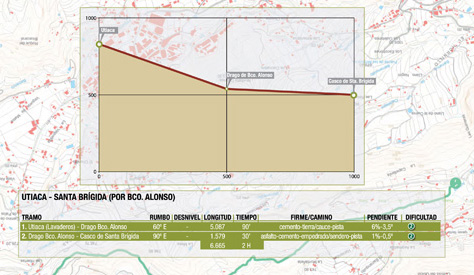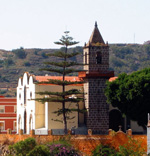
Villa de Santa Brígida - Teror
GENERAL DESCRIPTION. The trail runs through a markedly traditional farming landscape, with fields where potatoes, seasonal vegetables and fruit are grown, and past the occasional livestock farm -raising mainly sheep and goats- and a range of agricultural infrastructures.
From a geological point of view, the predominant material consists in old basaltic lava flows that belong to the Roque Nublo series. One of the trail's highlights is the Caldera de Pino Santo, in the municipality of Teror. It is a great depression brought about by the subsidence of the volcanic edifice. The material (lapilli) on the sides and the bottom of the caldera have been considerably altered, there has been a concentration of sedimentary deposits and a very rich soil -ideal for farming- has developed.
 For the inhabitants of Santa Brígida the trail to Teror is always associated with the pilgrimage in honour of the Virgen del Pino (Virgin of the Pine). Every year, on 7th September , many of them travel to Teror on foot to visit the Basilica of Our Lady of the Pine.
For the inhabitants of Santa Brígida the trail to Teror is always associated with the pilgrimage in honour of the Virgen del Pino (Virgin of the Pine). Every year, on 7th September , many of them travel to Teror on foot to visit the Basilica of Our Lady of the Pine.
The itinerary they cover traverses a great part of a protected natural area, the Paisaje Protegido de Pino Santo (Pino Santo Protected Landscape). It is an easy trail to follow as it is well preserved, it is well signposted and most of it runs along tarmacked roads.
 Trail description
Trail description
Stage 1: Iglesia de Santa Brígida-Cruz de Morales
The starting point of our trail is calle Muro street, just off calle Real street, at the entrance to the village of Villa de Santa Brígida. We walk down calle Muro street, past the church, as far as the power tower, where we take the cobbled path that leads down to the streambed of the Barranco de Santa Brígida ravine. Once there we take a path that will bring us to calle Francisco Bravo de Laguna street. We carry on along this street towards the north until we come to an area known as Los Silos, where there are old granaries or silos dug into the rock. We'll also be able to observe the columnar jointing that resemble organ pipes. As we cross over the bridge, if we turn and look back we'll see the centuries-old Pino Santo dragon tree perched on the edge of an escarpment of the Barranco Alonso ravine. The whole itinerary runs along a tarmacked road. 150 metres away from the bridge, in the direction of the village Pino Santo, we take a path to our right that brings us to a scenic viewpoint, Cruz de Morales, which offers splendid panoramic views of most of the municipality's territory.
Stage 2: Cruz de Morales-Cruce de Pino Santo Alto-Bajo
We carry on along the main road in the direction of Pino Santo Alto until we get to a clearly signposted crossroads where we take the turning to the hamlet of Lomo Carrión.
Stage 3: Pino Santo Alto-Bajo-Caldera de Pino Santo crossroads
 We go up the tarmacked road towards Lomo Carrión, past a house and as far as a turning to the right, Cuesta de las Pitas, and by house number 15 we take a concrete path to the left of the tarmacked road. The path is signposted with a sign that reads "p´al Pino". The path comes to an end on the border with the municipality of Teror, where we'll find further signposts marking the trail towards Teror. We'll walk past a wooden cross and carry on until we get to the turning to Espartero to the right. We turn left, past the northern wall of the Pino Santo Caldera -whose bottom has been turned into farmland-, opposite a rural house.
We go up the tarmacked road towards Lomo Carrión, past a house and as far as a turning to the right, Cuesta de las Pitas, and by house number 15 we take a concrete path to the left of the tarmacked road. The path is signposted with a sign that reads "p´al Pino". The path comes to an end on the border with the municipality of Teror, where we'll find further signposts marking the trail towards Teror. We'll walk past a wooden cross and carry on until we get to the turning to Espartero to the right. We turn left, past the northern wall of the Pino Santo Caldera -whose bottom has been turned into farmland-, opposite a rural house.
Stage 4: Caldera de Pino Santo-Turning towards El Faro
We walk on along this road. There is a small grove of eucalyptus trees on the left-hand side and some farming terraces to the right. When we get to a crossroads we turn to the right (El Faro-Las Palmas) and walk down towards El Faro. In the distance ahead of us we can see the city of Las Palmas de Gran Canaria, Las Canteras beach and La Isleta.
Stage 5: Turning towards El Faro-Teror

El Faro is a small settlement that lies on both sides of the road. The first building we come to is a rural school. In former times there were also a village shop (Luisito's) and a gofio mill. We'll get to a small hollow where cars park or turn round and where we'll find some steps by a house to the left. We go down those steps and get to a very steep concrete track, known as Cuesta Falcón. From the bottom of the ravine we can already make out the Basilica of the Pine . We carry on along this tarmacked road with the village of Teror and its chuch domes within sight. We walk across the ravine and take the El Chorrito street. As we walk uphill we'll come across a children's playground to the left and one of the many renowned butcher's shops in Teror to the right. We carry on straight ahead, entering the village's central pedestrian area. Our trail ends at the back of the basilica, the temple dedicated to Our Lady of the Pine.
This church is home to the Virgin of the Pine, patron saint of the Eastern Canarian diocese. The temple dates from 1767, although already at the beginning of the 16th century there was a chapel dedicated to the image  of the Virgin that had appeared on a nearby pine tree -hence the name. The church has undergone several reforms, for the ground on which it is built has tended to slip, causing cracks and threatening the building's stability. Two extensive reforms were undertaken in 1968 and 1969, the latter of which established the present design of the basilica.
of the Virgin that had appeared on a nearby pine tree -hence the name. The church has undergone several reforms, for the ground on which it is built has tended to slip, causing cracks and threatening the building's stability. Two extensive reforms were undertaken in 1968 and 1969, the latter of which established the present design of the basilica.
The building has a gable roof with Canarian style roof tiles. The church interior is divided into three naves separated by fourteen semicircular arches supported on columns and pilasters.
There are three doors -a main door and two side ones- on the façade, and an older tower built of yellow stone (salic material) from local quarries. The clock on the frontispiece was donated by bishop Codina. There are further doors on the sides of the church and another one on the back that leads to the Virgin's dressing room, where her clothes and trappings are kept. The stained glass windows depict the mysteries of the rosary.
Santa Brígida parish church
The present church is an example of a building process that is frequent on Gran Canaria: this is the third parish church raised on the same site as the two previous ones.
In 1697, don Francisco Martín Naranjo was the parish priest at the time, the building of the second church was started as the first chapel had become too small for the village's growing population. The total cost of the work was 43,545 Spanish reales. It was a building with three naves "with walls of ordinary masonry bound with lime mortar, and columns, door frames, buttresses and outside corners made of stone". Five semicircular side arches divided the main from the lateral naves. The façade looked east, and it had two doors on the west-facing back elevation and another door each on the north and south facing elevations.
In 1753 the construction of the tower was begun, and it was finished in 1759.
On the night between 21st and 22nd October 1897, however, a violent fire destroyed the interior of the church. Only part of the outside walls and the bell tower were salvaged.
The construction of the third church started in 1904. It was raised preserving the same orientation as the temple lost in the fire, with the entrance door on the northern elevation, next to the restored bell tower.
The Virgin of the Pine
The Virgin of the Pine is more than a reference for Gran Canaria, it is central to the Marian tradition to which for over five centuries the inhabitants of Gran Canaria have trusted their hopes and longings. It forms part of our history well beyond its religious dimension, however important the latter has been in the evolution of the island's history and traditions.
Teror is a fundamental element in the Marian cult of the Virgin of the Pine. It is the most important festivity in the municipality of Teror and indeed on the island as a whole. The Virgin of the Pine was canonically crowned in 1905, and in 1914 it was declared Patron of the Eastern Canarian Diocese by Pope Pius X.
There are different opinions and hypotheses on the apparition of the Virgin of the Pine in 1481. It is believed that there used to be a prehispanic sanctuary in the forest of Teror and that this became the basis of the later christian Marian devotion. The history of this festivity dates from the 16th century, when the Virgin would be transported to Las Palmas de Gran Canaria to perform rogations for rain. The pilgrimages on 8th September started at the beginning of the 18th century, the number of the faithful increasing to such an extent that women were forbidden from entering the main chapel, although this was later revoked for good. At present tradition dictates that pilgrims travel to Teror on foot during the night between 7th and 8th September.


















